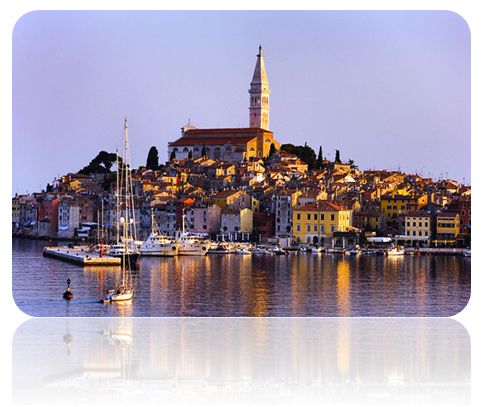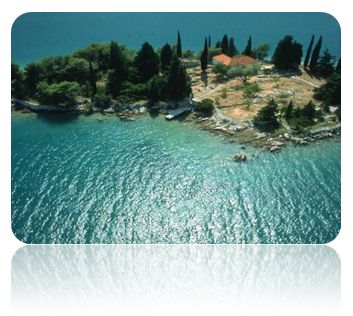Every season and every corner of the Croatian coast and islands can spin a remarkable tale about this unique Mediterranean country. A holiday in Croatia will give you the opportunity to discover the places and events behind the tales.
We have selected some must see places for your trip to Croatia.
• Hum
The smallest city in the world according to the Guinness Book of World Records.In the central part of Istria, 14 km southeast of Buzet is Hum, the smallest city in the world with a population of only 23 citizens. The small town was first mentioned in 1102 under the name Cholm, and as such is still known as Colmo in Italy to this day. Although it was established in the Middle Ages, Hum has preserved all of the distinctive features of urban architecture that are characteristic of acropolis settlements and although small it was the center of Glagolitic literacy during the Middle Ages.
On one side it is closed off by urban defensive towers and a system of walls, while the other side is enclosed by the outer walls of houses. The bell-tower dates back to 1552 while St. Jerome's Parish Church guards a rich collection of a late Gothic chalice, a ciborium and other liturgical objects. Frescoes dating back to the 12th century that were created under the strong Byzantine influence are particularly valuable to the parish church which is not surprising when one learns that Hum was the residence of one of the richest patriarchal servants. What is remarkable about Hum is that along with nearby Roc, it was the center of Glagolitic literacy during the Middle Ages. In the church today is a Glagolitic graphite dating back to the 12th century which is among the oldest monuments of Glagolitic script in Istria. In memory of this valuable heritage, in 1977 the Glagolitic Lane was opened, a monumental complex that consist of 11 landmarks set up along a 7 km long walking path from Hum to Roc.
Accommodation: Opatija, Motovun, Lovran, Rijeka, Moscenicka Draga
• Ston
The city in which the "European Wall of China" is located. A system of fortified walls and accompanying buildings built during the 14th century in defense against Turkish attack stretches between Ston and Mali Ston. During the time of the Dubrovnik Republic, the walls were restored and additions were made while their full length measured 5.5 km. The wall had as many as 40 towers and 7 fortresses and due to its monumentality and sturdiness it was named the "European Wall of China". The basis of the defense system, which was so carefully worked out that the city was literally unconquerable on land, consisted of three fortresses: Veliki Kastio in Ston, Koruna in Mali Ston and the fortress on the Podzvizd hill. Veliki Kastio was a residential house, granary and armorer's shop all in one. Koruna, a strong fortress with five towers facing the sea, first began to be constructed in 1347 and was used for centuries as a shipping port for salt. After the fall of the Dubrovnik Republic demolition of the walls began and the blocks were sold as building material for the construction of schools and municipalities. The remains of the three towers as well as parts of the magnificent wall can still be seen today and one absolutely must taste the oysters from the famous Ston oyster beds.
Accommodation: Brijesta, Broce, Dingac, Mali Ston, Veliki Ston, Cavtat, Dubrovnik, Plat, Janjina, Kuciste, Luka Dubrava, Prapratna, Orebic, Trpanj, Viganj, Zuljana, Zaton, Srebreno
• Makarska
A city in which the most valuable snails and shells in the world are kept.The Malakoloski museum is situated in the basement of a Franciscan convent in Makarska, in other words, a museum of shells and snails and considered to be the most valuable collection in the world. Aside from shells and snails, which are not only presented from a morphological-biological aspect, but also as a historical-cultural phenomenon that includes the history of shells as a source of food as well as a form of currency, the museum keeps a smaller collection of fossil remains from the Makarska coastland and hinterland. The museum exhibits originate from the Adriatic Sea as well as the world's oceans, thus the significance of this collection exceeds regional significance. The convent's treasure also consists of a systematized archive, a rich library as well as a collection of paintings and artistic objects of great value. Accommodation: Makarska, Omis, Podgora, Tucepi, Igrane, Gradac, Bratus, Brela, Zivogosce
The smallest city in the world according to the Guinness Book of World Records.In the central part of Istria, 14 km southeast of Buzet is Hum, the smallest city in the world with a population of only 23 citizens. The small town was first mentioned in 1102 under the name Cholm, and as such is still known as Colmo in Italy to this day. Although it was established in the Middle Ages, Hum has preserved all of the distinctive features of urban architecture that are characteristic of acropolis settlements and although small it was the center of Glagolitic literacy during the Middle Ages.
On one side it is closed off by urban defensive towers and a system of walls, while the other side is enclosed by the outer walls of houses. The bell-tower dates back to 1552 while St. Jerome's Parish Church guards a rich collection of a late Gothic chalice, a ciborium and other liturgical objects. Frescoes dating back to the 12th century that were created under the strong Byzantine influence are particularly valuable to the parish church which is not surprising when one learns that Hum was the residence of one of the richest patriarchal servants. What is remarkable about Hum is that along with nearby Roc, it was the center of Glagolitic literacy during the Middle Ages. In the church today is a Glagolitic graphite dating back to the 12th century which is among the oldest monuments of Glagolitic script in Istria. In memory of this valuable heritage, in 1977 the Glagolitic Lane was opened, a monumental complex that consist of 11 landmarks set up along a 7 km long walking path from Hum to Roc.
Accommodation: Opatija, Motovun, Lovran, Rijeka, Moscenicka Draga
• Ston
The city in which the "European Wall of China" is located. A system of fortified walls and accompanying buildings built during the 14th century in defense against Turkish attack stretches between Ston and Mali Ston. During the time of the Dubrovnik Republic, the walls were restored and additions were made while their full length measured 5.5 km. The wall had as many as 40 towers and 7 fortresses and due to its monumentality and sturdiness it was named the "European Wall of China". The basis of the defense system, which was so carefully worked out that the city was literally unconquerable on land, consisted of three fortresses: Veliki Kastio in Ston, Koruna in Mali Ston and the fortress on the Podzvizd hill. Veliki Kastio was a residential house, granary and armorer's shop all in one. Koruna, a strong fortress with five towers facing the sea, first began to be constructed in 1347 and was used for centuries as a shipping port for salt. After the fall of the Dubrovnik Republic demolition of the walls began and the blocks were sold as building material for the construction of schools and municipalities. The remains of the three towers as well as parts of the magnificent wall can still be seen today and one absolutely must taste the oysters from the famous Ston oyster beds.
Accommodation: Brijesta, Broce, Dingac, Mali Ston, Veliki Ston, Cavtat, Dubrovnik, Plat, Janjina, Kuciste, Luka Dubrava, Prapratna, Orebic, Trpanj, Viganj, Zuljana, Zaton, Srebreno
• Makarska
A city in which the most valuable snails and shells in the world are kept.The Malakoloski museum is situated in the basement of a Franciscan convent in Makarska, in other words, a museum of shells and snails and considered to be the most valuable collection in the world. Aside from shells and snails, which are not only presented from a morphological-biological aspect, but also as a historical-cultural phenomenon that includes the history of shells as a source of food as well as a form of currency, the museum keeps a smaller collection of fossil remains from the Makarska coastland and hinterland. The museum exhibits originate from the Adriatic Sea as well as the world's oceans, thus the significance of this collection exceeds regional significance. The convent's treasure also consists of a systematized archive, a rich library as well as a collection of paintings and artistic objects of great value. Accommodation: Makarska, Omis, Podgora, Tucepi, Igrane, Gradac, Bratus, Brela, Zivogosce




For more information go to www.croatia.hr